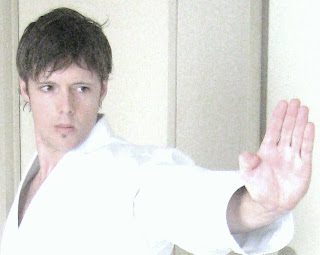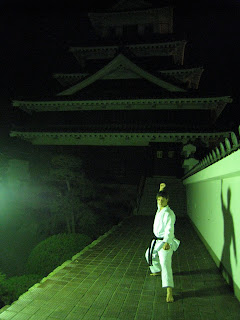 Please excuse my lack of posts recently. I only managed to make three last month as I was being a 'slow writer' (I always endeavor to churn out four articles/posts per month). My average time writing each post is between five minutes and quarter of an hour. Once I get past 15 minutes, I cannot justify the time. Anyway… Several of my former students have emailed me, requesting I post my latest self-training routine. So here you are! I wish you all the very best in your training. – Osu! André.
Please excuse my lack of posts recently. I only managed to make three last month as I was being a 'slow writer' (I always endeavor to churn out four articles/posts per month). My average time writing each post is between five minutes and quarter of an hour. Once I get past 15 minutes, I cannot justify the time. Anyway… Several of my former students have emailed me, requesting I post my latest self-training routine. So here you are! I wish you all the very best in your training. – Osu! André.___________________
KihonThis month I have returned to the theme of ‘simple is best’. That is, I’m working on the ‘core fundamentals’ of Shotokan-Ryu. In particular I’m focusing on koshi no kaiten with the five basic blocks (jodan age-uke, chudan soto-uke, chudan uchi-uke, gedan-barai and chudan shuto-uke) followed by the respective reverse hand counters. Emphasis is on a tight hanmi followed by a sharp rotation/forward thrust into an exact shomen. As simple as this seems, I am challenging myself to increase the sharpness of my torso action, whilst maintaining smoothness/precision. I’m also putting much effort into oi zuki and oi-geri (mae-geri, yoko-keage, mawashi-geri and yoko-kekomi). My concentration is on the drive of the rear/supporting leg. How simple can you get? Well at least for me, this training is simple, but far from easy... Lastly I’m practicing gyaku-zuki from a ‘compressed to the extreme’ jiyu-dachi concentrating on maximum tai no shinshuku and koshi no kaiten. Emphasis is once again on an extreme contraction of the stance (maintaining perfect pelvic alignment) and sharp spring/rotation/thrust into zenkutsu-dachi. Techniques include gyaku zuki with seiken, teisho, shihon nukite and yokomawashi empi uchi.
___________________
Kata
At present the kata I’m training include a random Tekki (Tekki-Shodan, Tekki-Nidan or Tekki-Sandan), Empi, Jion, Unsu and Gojushiho-Dai. In addition to these, last month at dojo training, Tachibana Shihan (8th Dan) microscopically dissected my Gankaku making nine alterations. So, I’ve also been allocating some time to this kata to reinforce what he taught me. Gankaku is not a kata I’m ov

erly fond of, however the alterations Tachibana Shihan taught me were all very practical. He demonstrated why these corrections would help my Gankaku with some lethal bunkai/oyo-jutsu. This was probably the best tuition I’ve ever received on this kata. I really have to say here that I'm very grateful for Tachibana Shihan’s weekly tuition! What’s more, Tachibana Shihan was also a student of Asai Shuseki-Shihan.
_________
Jiyu ippon kumite
I'm seeking maximum use of tai no shinshuku and koshi no kaiten in each of my counters. Essentially extreme contraction of the stance for defense, then explosive expansion/stretch for offence. The entire body, mind and spirit decisively committed in one moment of time... For the attacking techniques I'm concentrating on correct ma'ai for optimal target penetration to potentially finish my opponent.
__________
I'd like to add some comments to wrap up this post about kumite and karate training in general. This is something I’ve really wanted to say for a while... Too many people practice karate knowing that if they got into a violent altercation, against a really strong attacker, that their karate would probably not work (as trained in their respective dojo). Clearly, if one has such doubts their dojo is not ‘physically focused’ on real karate (ichigeki hisho - the single finishing blow) when they practice. It goes without saying, such dojo are spreading fake karate. Karate without aiming to achieve ichigeki-hisho, at all times, will literally make you less capable of handling yourself in real fight. If you are playing karate, you are ‘playing’. If you are doing karate seriously as a martial art, you are doing ‘karate’. In either case, the physical training itself is what establishes what you are actually doing. And proper physical training can only be achieved in a high stress (dangerous) environment. If you don't block properly, your face will most certainly be covered in blood, perhaps a trip to the hospital or dentist. I'm not saying I like this to happen, but without this factor, one cannot improve self-protection skills. The reality is that so many karate clubs are nothing more than 'play grounds' labeled as ‘karate dojo’.
Perhaps my mentality is now viewed as extreme, but in reality, my self-practice simply illustrates how soft so many karateka, dojo and organisations have become (playing ‘karate’). I'm not special or talented, I am simply doing, what up until the mid to late 1980's, was considered as 'orthodox karate'. My current training routine continues to follow this karate way, that is, karate as an effective martial art.
 _________
_________
© André Bertel, Japan 2008
 Often, at the Saturday class, Tachibana Shihan tells us to each select a kata we individually wish to work on. Last Saturday, after jiyu-kumite, I decided to do a kata which I’ve been neglecting for a fair while. The three Shotokan-ryu kata which initially came to mind were Jiin, Chinte and Wankan, I randomly chose to do Chinte, and certainly do not regret this decision! The tips, and corrections I received, turned out to be priceless.
Often, at the Saturday class, Tachibana Shihan tells us to each select a kata we individually wish to work on. Last Saturday, after jiyu-kumite, I decided to do a kata which I’ve been neglecting for a fair while. The three Shotokan-ryu kata which initially came to mind were Jiin, Chinte and Wankan, I randomly chose to do Chinte, and certainly do not regret this decision! The tips, and corrections I received, turned out to be priceless. r me really establish why 'I'm living in Japan'. It is insufficient to simply come here to train for a couple of weeks (like so many do and brag about it). In reality you need to be in Japan, training daily, for at least a month, merely to get 'a feeling' of traditional Japanese karate-do, and ideally train here for many years, under an 8th or 9th Dan Shihan.
r me really establish why 'I'm living in Japan'. It is insufficient to simply come here to train for a couple of weeks (like so many do and brag about it). In reality you need to be in Japan, training daily, for at least a month, merely to get 'a feeling' of traditional Japanese karate-do, and ideally train here for many years, under an 8th or 9th Dan Shihan. r me really establish why 'I'm living in Japan'. It is insufficient to simply come here to train for a couple of weeks (like so many do and brag about it). In reality you need to be in Japan, training daily, for at least a month, merely to get 'a feeling' of traditional Japanese karate-do, and ideally train here for many years, under an 8th or 9th Dan Shihan.
r me really establish why 'I'm living in Japan'. It is insufficient to simply come here to train for a couple of weeks (like so many do and brag about it). In reality you need to be in Japan, training daily, for at least a month, merely to get 'a feeling' of traditional Japanese karate-do, and ideally train here for many years, under an 8th or 9th Dan Shihan.




.JPG)



